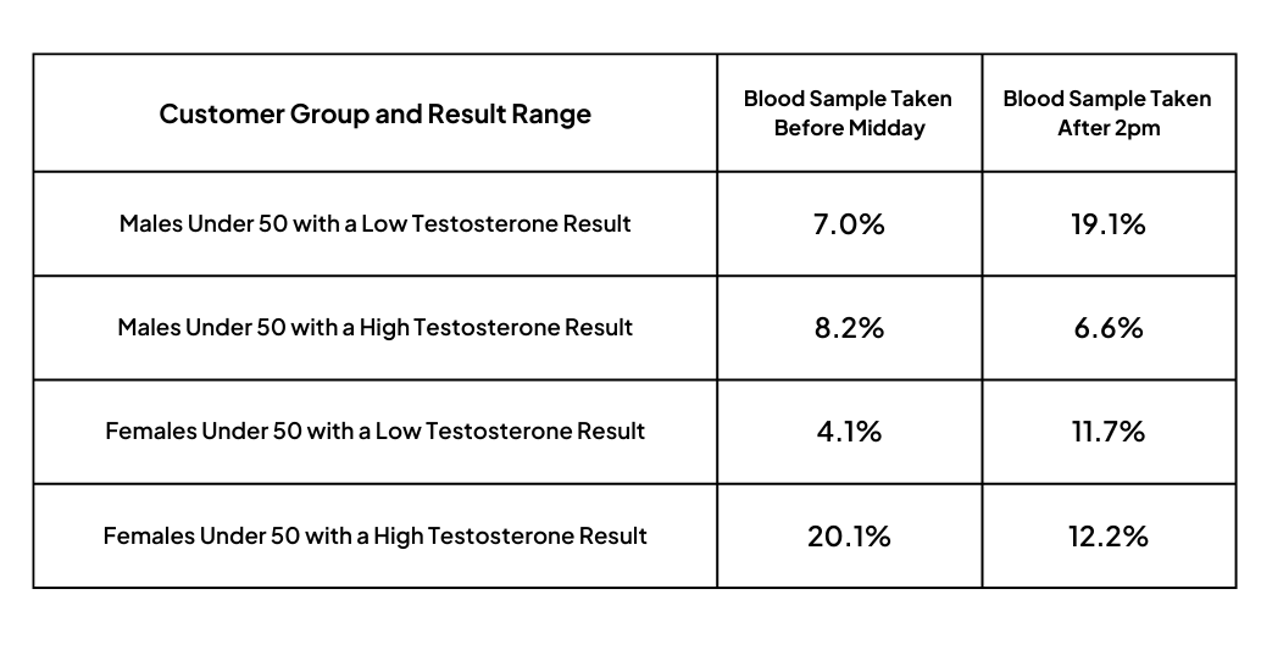The impact of natural 24-hour fluctuations on blood test results



Some of the biomarkers we test at Thriva have a natural fluctuation across a single day, and so the timing of a blood sample can directly influence results. Many of these are due to the body’s internal 24-hour clock, known as the circadian rhythm.
Your body operates on a 24-hour cycle, regulating essential biological functions like hormone secretion, metabolism, and immune responses. If a biomarker follows a circadian pattern, we may see it rise sharply early in the morning, drop to a low in the afternoon, and then rise again in the evening.
At Thriva we recommend taking your blood test in the morning, having fasted for at least 8 hours, yet we see that 1 in 8 users take their test after midday. When their test includes certain biomarkers with a diurnal (24 hour) variation, it can influence their likelihood of receiving an abnormal result.
For this article we have aggregated our users blood test results from 2023 and 2024 to explore these trends and see how they align with existing research.
Testosterone
Testosterone is a sex hormone present in both males and females, with males having values 10 to 20 times higher. The circadian rhythm plays a role in regulating testosterone, and values are typically highest around 8am with a steady decline throughout the day. The magnitude of this decline gets smaller with age - people under 30 might see a decline of 30% between morning and evening readings, while people over 60 may see declines less than 10%.

The knock-on effect of testing outside of the recommended window is that your result will not align with the reference ranges. Males under 50 were almost three times more likely to receive a low testosterone result (< 8.64 nmol/L) when testing after 2pm compared to testing before midday. Females saw a similar increase in low testosterone results and were also less likely to have high testosterone levels after 2pm.

Thyroid-stimulating hormone
Thyroid-stimulating hormone (TSH) is one of the key biomarkers for the diagnosis and monitoring of thyroid conditions. The thyroid gland can be overactive (hyperthyroidism) or underactive (hypothyroidism). Hypothyroidism is more common, and one of the criteria would be high TSH levels. It affects around 2% of the population, and is up to 10 times more common in women.
Important: High TSH levels are rarely judged in isolation, and are usually assessed alongside other markers like low Free Thyroxine (FT4) in the diagnosis of hypothyroidism. Time of day is unlikely to influence diagnostic outcomes. However, we recommend that tests are done fasted in the morning to ensure consistency.
Our data shows that Thriva users taking their sample before 8am have average TSH levels of 2.92 mIU/L, while those testing between 10am and 5pm have levels 24% lower at 2.09 mIU/L. While this makes users up to four times more likely to have high levels of TSH (> 4.2 mIU/L), this marker is not judged in isolation and therefore does not impact diagnostic accuracy.
This graph illustrates the benefits of testing at the same time of day to help interpret your own trends, as consistent sample timing limits biological variation.

Serum Iron
Iron is used to make haemoglobin, which is the part of red blood cells that carries oxygen around your body. If you don't get enough iron in your diet you might develop a condition known as iron deficiency anaemia. This is most common in menstruating women as well as individuals who follow a low iron diet, more commonly vegetarians and vegans. High iron levels could be due to supplementation, genetic conditions such as haemochromatosis, or excessive consumption of iron-rich foods.
Important: Iron levels are rarely judged in isolation, and are usually assessed alongside other markers like Ferritin and Total Iron Binding Capacity (TIBC) in determining the body’s iron status.
Serum iron levels follow a circadian rhythm, peaking late morning before declining from mid-afternoon through to the evening. The effect this has on results from our female users is clear in the following graph. Female users are 50% more likely to receive a “low” serum iron result (< 10 umol/L) when testing in the early afternoon compared to the morning. Our male users see more “high” serum iron results (> 30 umol/L) than females (18.6% vs. 10.3%), and the percentage of “high” results drops sharply after midday.

Triglycerides
Triglycerides, which measure circulating fat levels, are influenced by both food intake and circadian rhythms. Levels can be higher after meals, making fasting a crucial factor when testing triglycerides. Circadian rhythms also play a role in lipid metabolism, meaning that time-of-day variations may exist even in fasting individuals.
Our data indicates a trend of rising Triglyceride levels after midday, with an average of 1.42 mmol/L in samples taken before 12pm rising as high as 2.15 mmol/L by 8pm. With the threshold for high triglycerides at 1.8 mmol/L, this leads to a much higher proportion of results being classified as high.
Before midday, 35.9% of results are optimal and 19.5% are high. In contrast, after 5pm only 16.8% are in the optimal range while more than double the proportion of samples are high, at 46.0%. While it’s possible for a user to be taking a test at 7am without fasting, or at 5pm fasted, it’s likely the effect we’re seeing here is down to food intake prior to the test.

Final Thoughts
These biomarkers represent the largest differences that can be seen due to the time of day a sample is collected. It’s important to remember that the majority of biomarkers show no significant effect when assessed by time of day and are therefore less sensitive to the time of day your sample is taken.
For the highest level of consistency in results you should always aim to take your test in the morning, following an eight hour fasting period, as described in our sample collection guidelines. This ensures comparability between tests by reducing the influence of natural fluctuations, making it easier to interpret your results over time. It also shows the value in repeat testing and appreciating the overall trend of your biomarkers rather than fully relying on an individual snapshot in time.
Stay tuned for more insights as we continue to analyse trends from our anonymised dataset, helping you take control of your health with data-driven knowledge.